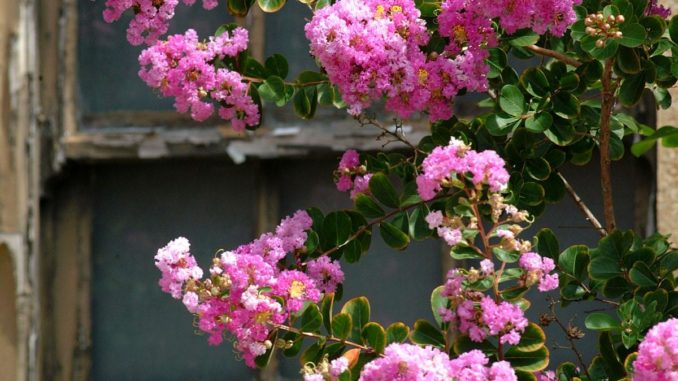
The most popular summer-blooming tree in Louisiana is the crape myrtle with its lovely, long-lasting flowers. Crape myrtles start blooming between mid-May and early June and continue flowering for 80 to 100 days depending on the variety. Sometimes you see crape myrtles that don’t bloom well. “Why?” you might ask. Poor performance happens for several reasons:
– Lack of growth. Crape myrtles need to have new growth each spring. If your crape myrtles did not produce much new spring growth, they will not have many summer flowers. Crape myrtles make flowers on the current season’s growth, so late winter/early spring fertilization can aid crape myrtle flowering in the summer. It is not too late to fertilize this year if you did not do so earlier.
– Shade. Crape myrtles require eight hours of direct sun daily to bloom well. Many times crape myrtles are planted in areas that receive 4 to 6 hours of direct sun or less – this is not enough for adequate bloom development.
– Variety. Some varieties don’t flower as vigorously as others. The hybrid crape myrtles usually flower first. Natchez, Tuscarora, Basham’s Party Pink and Muskogee are the earliest flowering varieties. Semi-dwarf varieties (Tonto, Acoma, Sioux) follow a week or two later.
– Insects. Heavy infestation of aphids decreases flowering. These are the most common insect problem on crape myrtles. Ever feel like you are being “rained” upon when you are under the canopy of a crape myrtle? That “rain” is actually bodily fluid being excreted from aphids. You can also have white flies and other insect issues on crape myrtles.
– Improper pruning. Drastic pruning or pruning after new growth in the spring can delay summer flowering. Drastic pruning may promote excessive growth and less flowering. Sometimes conducting the “crape murder” method of pruning on crape myrtles can initiate too much vegetative growth at the expense of flowering.
– Too much fertilizer. Excessive fertilization, especially high amounts of nitrogen, in conjunction with other factors, primarily improper pruning, can eliminate or delay flowering.
– Leaf spot. Foliar diseases decrease plant vigor and flowering, especially where new growth is not produced in the spring. The main leaf spot infecting crape myrtles is the fungus Cercospora.
– Wet soil. Crape myrtles need well-drained areas to grow well. Lichen growing on the bark is common on crape myrtles growing in shady areas accompanied by poorly drained soils and low levels of native soil fertility.
So, that is the list. Hopefully your crape myrtles will bloom and bloom some more for you this summer. Consider these ideas if you have crape myrtles not performing to their potential.
Come to LaHouse in Baton Rouge to see AgCenter crape myrtles and sustainable landscape practices in action. The home and landscape resource center is located near the intersection of Burbank Drive and Nicholson Drive (La. Highway 30) in Baton Rouge across the street from the new LSU baseball stadium. For more information, go to www.louisianahouse.org and www.lsuagcenter.com/lyn.




Be the first to comment